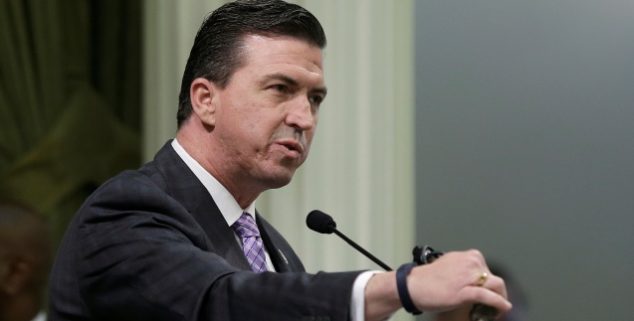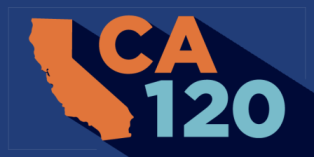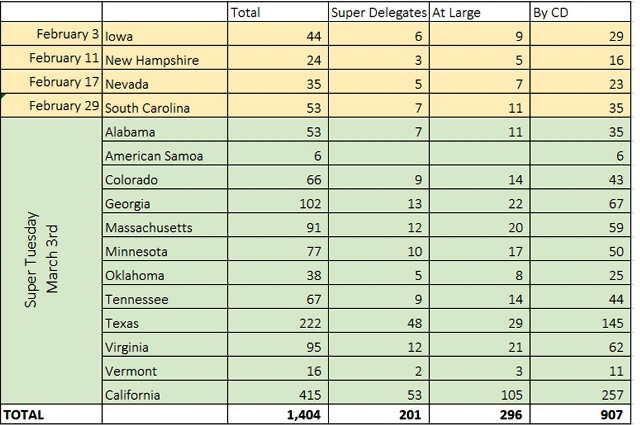News
UPDATE: CA120: Probing the early primary
 Assemblyman Kevin Mullin, who along with Sen. Ricardo Lara authored the early primary legislation, addressing the Assembly in May. (Photo: AP/Rich Pedroncelli)
Assemblyman Kevin Mullin, who along with Sen. Ricardo Lara authored the early primary legislation, addressing the Assembly in May. (Photo: AP/Rich Pedroncelli)(Ed’s Note: UPDATES with Gov. Brown signing early primary legislation.)
Gov. Brown on Wednesday signed legislation to move California’s 2020 primary election from June to March.
The bill, SB 568 by state Sen. Ricardo Lara, D-Bell Gardens, pushes California to nearly the head of the line.
But not the very front — the first four spots in the nominating calendar are still reserved for Iowa, New Hampshire, Nevada and South Carolina.
But with the March 3 date, California moves as far forward it can without facing punitive measures. The state joins a Super Tuesday that includes a number of southern states, including Texas and Virginia.
California has on three different occasions moved the primary election to an earlier spot on the calendar with hopes that California would shape the outcome of the race.
But each time this has not been the result.
The only consistent impact of this early date has been a lot of rainy and cold precinct walks and an accelerated calendar for fundraising in the fall of the preceding year.
With just three examples, there really isn’t enough experience to confidently say that the early primary doesn’t improve the state’s chances to matter in the process.
And rather than view it through the simple calculation of the date’s ability to empower California’s electorate in any one given year, we should be thinking about it in terms of probabilities.
While not the focus of most political analyses, the early move could allow California to have a greater impact on the early stages of the Republican nomination if President Trump faces a challenger.
With a June date, there is a very small probability for a massive impact. As we nearly saw in the 2016 election, California could be the deciding vote after a months-long primary process. With a huge cache of votes, and an incredibly tight race, California could decide which candidate takes the stage at the national nominating convention and which one sits on the sidelines.
But how often do these kind of cases come up in presidential politics?
Answer: Almost never.
With a March date, we lose that opportunity to be the last big hope for a campaign but we do get in as the biggest prize in the building of campaign momentum.
Traditionally, partisan presidential campaigns are down to two or three candidates by April, and California would have an extremely high likelihood of playing a major role in this narrowing process.
While not the focus of most political analyses, the early move could allow California to have a greater impact on the early stages of the Republican nomination if President Trump faces a challenger. And if a prominent senator or governor is sizing up their prospects for 2020, an early California primary could make a run look more promising.
California would be a necessary target for any presidential campaign that is trying to make it into the winnowed field.
In the 2016 primary, California Republicans saw their lowest ever turnout in a presidential contest. Among those who cast ballots, 10% left the presidential contest blank while another 15% cast their ballots for another candidate, despite Trump being the only active candidate in the race at that time. (Ed’s Note: On Tuesday, Capitol Weekly will release the results of post-election polling of Trump voters).
However the majority of the focus on the early primary is on the Democratic side.
Looking at the Democratic Party process for 2020, we can see the current expected lineup of early primaries and caucuses and find that California (even after losing 70 delegates for changing dates) would be 30% of all delegates awarded in total, and 33% of Super Tuesday.
California would lose 70 delegates because the Democratic National Committee earlier approved giving California an incentive of 70 convention delegates if the state moved its primary to June. By moving it to March, California loses that incentive.

Graphic: Paul Mitchell
With California accounting for a third of the delegate haul to that point, the state would be a necessary target for any presidential campaign that is trying to make it into the winnowed field.
Some states might move up their primaries to match California. Already Oregon has taken steps, but under most scenarios, California would still be at least 25% of the total delegates awarded on Super Tuesday.
This impact is even greater if you consider the possibility for California to launch one of our own into the presidential nomination.
Los Angeles Mayor Eric Garcetti, for example, could look at the 30% of total delegates from California, and combine that with the heavily Latino Democratic electorate in Texas and Nevada which account for another 26% of the total delegates awarded.
In a non-traditional pathway to the presidency, let’s call it the Southwest Airlines path, Garcetti could lean heavily on the 56% of delegates that would be awarded by these three states and walk out of March 3 as a major front-runner in the Democratic nomination.
Alternatively, Kamala Harris could see another path, one that more traditionally banks on a home state base and the heavily African American states of South Carolina, Alabama, Georgia, Tennessee and Virginia, which are collectively 38% of the delegates awarded by Super Tuesday.
Combine the California base with these southern African American states, and even throw in the heavily Asian American Samoa, and you’ve got Kamala Harris with a geographic base which comprises 68% of the delegates awarded.
If you’re looking to launch a California native into the national scene, the early primary is almost imperative.
This is not to suggest that Garcetti is going to win all the Latino states, or that Harris is going to win all the African American states, but these are areas in which they could over-perform, similar to how in the US Senate race, Harris over-performed in her San Francisco base, or how in a statewide race, Garcetti would be expected to over-perform in Los Angeles. This is also dependent on just one of them running – as California’s delegate haul divided wouldn’t have nearly the impact.
In addition to the delegate haul advantages of a California presidential run, there are also huge implications for fundraising.
California has been the traditional ATM for Democratic campaigns, and either a Garcetti or Harris entry to the nominating process could lock up dollars that would be usually available to a Corey Booker, Elizabeth Warren or Joe Biden candidacy.
So, if you’re looking for a more likely impact in the national nominating process, then an early date is the much better choice. And if you’re looking to launch a California native into the national scene, it is almost imperative.
And when you’re walking precincts in rainy and cold January and February, instead of warm and sunny April and May, just blame Ricardo Lara.
Want to see more stories like this? Sign up for The Roundup, the free daily newsletter about California politics from the editors of Capitol Weekly. Stay up to date on the news you need to know.
Sign up below, then look for a confirmation email in your inbox.

What year did Calif. have an early primary beside 2004 and 2008?